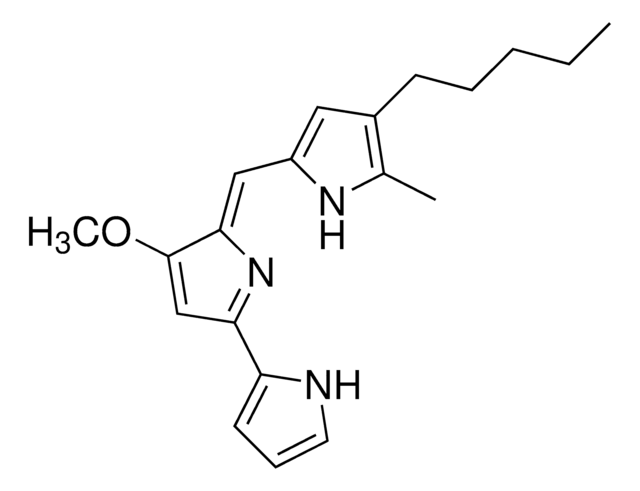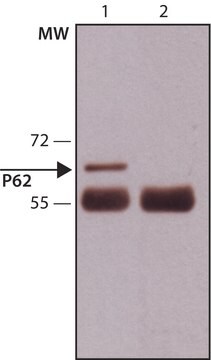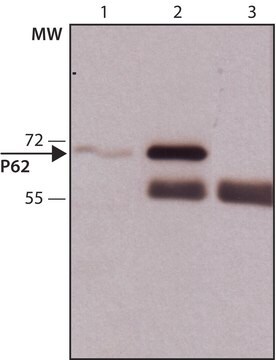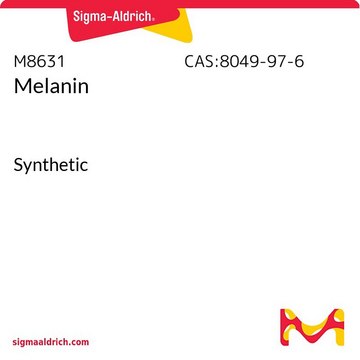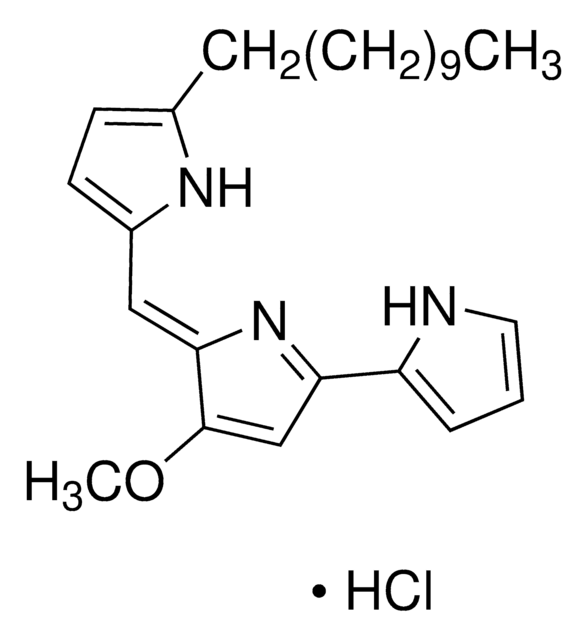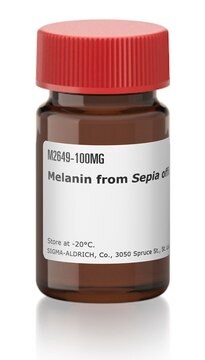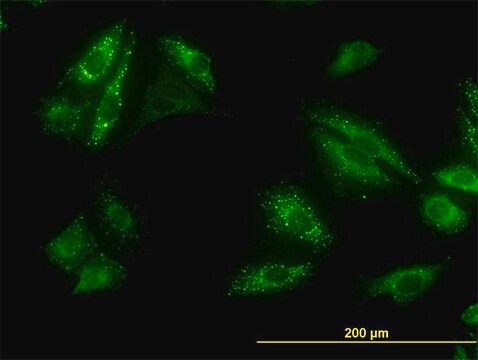P0103
Prodigiosin hydrochloride
from Serratia marcescens, ≥98% (HPLC), powder
Synonym(s):
2,2′-Bi-1H-Pyrrole,4-methoxy-5-[(5-methyl-4-pentyl-2H-pyrrol-2-ylidene)methyl, 2-Methyl-3-amyl-6-methoxyprodigiosene hydrochloride
Sign Into View Organizational & Contract Pricing
All Photos(1)
About This Item
Empirical Formula (Hill Notation):
C20H25N3O · HCl
CAS Number:
Molecular Weight:
359.89
UNSPSC Code:
12352200
NACRES:
NA.32
Recommended Products
biological source
Serratia marcescens
Quality Level
Assay
≥98% (HPLC)
form
powder
solubility
DMSO: soluble
H2O: insoluble
acetonitrile: soluble
chloroform: soluble
methanol: soluble
shipped in
wet ice
storage temp.
−20°C
General description
Prodigiosin is a red pigment with common pyrrolyl pyrromethene skeleton and is biosynthesized by Serratia marcescens and other bacteria.
Biochem/physiol Actions
Prodigiosin (PG) exhibits antibacterial, anticancer, cytotoxic, immunosuppressive and antiproliferative activities. Prodigiosin stimulates apoptosis in hematopoietic cancer cells and in cells derived from other human cancers, such as gastric and colon, with no marked toxicity in nonmalignant cell lines. In addition, prodigiosin also has p53-independent anti-proliferative activity. Experimental studies show that prodigiosin promotes various cellular processes such as cell shrinkage, chromatin condensation, restructuring of actin microfilament network and detachment of cells from the cell culture substrate. Different targets and mechanisms of action were described for prodigiosin, including induction of single- and double stranded DNA breaks modulation of pH, regulation of mitogen-activated protein kinase, and inhibition of cell cycle progression.
Prodigiosin, a tripyrrole red pigment biosynthesized by Serratia marcescens and other bacteria, exhibits antibacterial, anticancer, cytotoxic, immunosuppressive, and antiproliferative activities. Prodigiosin induces apoptosis in hematopoietic cancer cells and cells derived from other human cancers, including gastric and colon with no marked toxicity in nonmalignant cell lines. Morphological analysis of prodigiosin-treated cells demonstrated that prodigiosin induces cell shrinkage, chromatin condensation, reorganization of actin microfilament architecture, and detachment of cells from the cell culture substrate. Different targets and mechanisms of action are described for prodigiosin, including induction of single- and double-strand DNA breaks, modulation of pH, regulation of mitogen-activated protein kinase, and inhibition of cell cycle progression.
Prodigiosin, a tripyrrole red pigment biosynthesized by Serratia marcescens and other bacteria, induces apoptosis and exhibits antibacterial, anticancer, cytotoxic, immunosuppressive, and antiproliferative activities.
Storage Class Code
11 - Combustible Solids
WGK
WGK 3
Flash Point(F)
Not applicable
Flash Point(C)
Not applicable
Personal Protective Equipment
dust mask type N95 (US), Eyeshields, Gloves
Choose from one of the most recent versions:
Already Own This Product?
Find documentation for the products that you have recently purchased in the Document Library.
T-cell specific immunosuppression by prodigiosin isolated from Serratia marcescens.
Han SB
International Journal of Immunopharmacology, 20(1-3), 1-13 (1998)
Beatriz Montaner et al.
Annals of the New York Academy of Sciences, 973, 246-249 (2002-12-18)
Prodigiosin (PG) is an active component of bacterial origin, with reported apoptotic effects. We examined the activation of caspases-9, -8, and -3 in PG-treated Jurkat cells in a dose-response study. These caspases were activated in apoptotic cells, as judged by
Daniel P Roberts et al.
AMB Express, 11(1), 10-10 (2021-01-08)
Ethanol extract of cell mass of Serratia marcescens strain N4-5, when applied as a treatment to cucumber seed, has been shown to provide control of the oomycete soil-borne plant pathogen Pythium ultimum equivalent to that provided by a seed-treatment chemical
Purification and characterization of prodigiosin produced by integrated bioreactor from Serratia sp. KH-95.
Song MJ
Journal of Bioscience and Bioengineering, 101(2), 157-161 (2006)
The prodigiosins, proapoptotic drugs with anticancer properties.
Perez-Tomas R
Biochemical Pharmacology, 66(8), 1447-1452 (2003)
Our team of scientists has experience in all areas of research including Life Science, Material Science, Chemical Synthesis, Chromatography, Analytical and many others.
Contact Technical Service